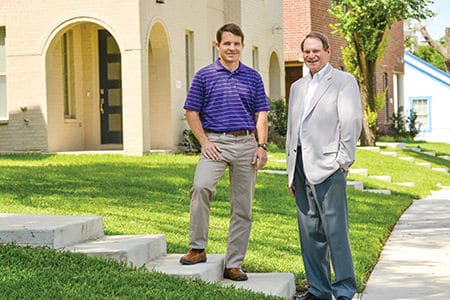Fort Worth Residential Permits
2013 Total Residential
8,115
2014 Total Residential
8,471
Source: City of Fort Worth
After 15 years raising his family in far North Fort Worth, Daniel Garcia was ready for a change of pace.
As their children grew up, Garcia and his wife began spending more time at movies, restaurants and shops in Fort Worth’s Seventh Street district. That led them to consider moving closer to downtown Fort Worth, where Daniel Garcia is assistant police chief.
Garcia’s desire to move “where the action is” came as Village Homes, known for residential developments in historic neighborhoods, started a new “infill” project in Linwood, a working-class neighborhood just west of downtown that was devastated by the 2000 tornado.
“I was very interested in their concept of revamping older communities with new construction,” Garcia said. “They were doing nice things in Monticello and the TCU area but this Linwood neighborhood intrigued me.
“It’s an older working-class neighborhood that is smack dab in the middle of a nice sought-after area. The movie theater. The night life. The whole attraction is that you can literally walk to anything.”
The proximity to Seventh Street had led Village Homes President Michael Dike and his partner, Jim Harris, to begin building 54 townhomes on 27 lots in the area bordered by Templeton Drive and West Fifth, Whitmore and Foch streets.
Dike said the firm has since bought more lots and now expects to build 74 homes in its Linwood Park development. A Dallas firm is also building homes in the Linwood area west of Montgomery Plaza. The lots were bought from redevelopment companies in recent years.
The Garcias were the first owners to close on their new Village Homes townhouse, where they have lived for about five months. Twenty homes are now occupied and 20 are under construction, with 34 not yet started, Dike said.
Dike and Harris are confident their townhomes will sell, even though the price for the roughly 2,000-square-foot, three-bedroom homes has risen since they started the project in 2013 – from the low to the high $300,000s.
While its early projects included homes priced up to $3 million around town, Village Homes has been focusing since 2004 on infill projects in existing neighborhoods including Arlington Heights, Monticello and Rivercrest, Dike said.
“This is not our first rodeo,” he said.
Although the firm has expanded into Arlington and Aledo and other suburbs, it has retained its focus on infill housing, where the market is very different, Harris said.
In addition to Linwood, Village Homes is building 144 townhomes in the River Bend area off White Settlement Road, Dike said.
Suburban buyers are more likely to have children or plan to have children, while buyers in Linwood and other urban areas tend to be “empty nesters” and young professionals, including single women, Harris said.
“We were surprised,” he said. “Single women are more apt to buy than single men. The neighborhood is the key here. It’s pedestrian-friendly.”
But Dike and Harris said buyers of their homes have some desires in common. The latest design trend is an “open-air concept” on the first floor, where dining, living and kitchen areas flow together instead of having formal dining and living rooms. Bedrooms and laundry rooms are on the second floor, they said.
Buyers also want flexibility, Dike said, with some preferring the two-car garage in the back yard, while others want the garage in front so they can build a pool in the back yard. Some Aledo houses offer a third bay in the garage to be used for a car, a craft room or something else, he said.
Energy efficiency is also a big plus for buyers, including appliances, light fixtures and a wrap-around foam insulation that adds $3,000 to the home price, Dike said.
As in suburban developments, walkability and a leafy outdoor environment are clearly pluses for Linwood, which includes Linwood-Jesse D. Sandoval Park, he said.
Eva Bonilla, a fourth-generation Linwood resident who recently built her own single-family home overlooking the park named for her father, agrees.
Bonilla was not living in Linwood in 2000 but her parents, Jesse and Elena, became advocates for the many poor residents who lost their homes either to the tornado or to developers who bought and tore them down.
While she’s not thrilled that Linwood‘s single-family homes are giving way to various types of multifamily units, she prefers the townhomes to the 4-story apartment complex that opened despite protests by her and others.
Now president of the Linwood Neighborhood Association that her late father once led, Bonilla has met with builders, apartment managers and business owners to encourage them to give back to their neighborhood.
Bonilla said she met with Dike, who has donated money and ice cream to neighborhood events. She also has asked him to help pay for more “street toppers” which identify Linwood with a tiny tornado to signify how it brought the neighborhood together.
“Village Homes is trying to be a good neighbor,” she said.






